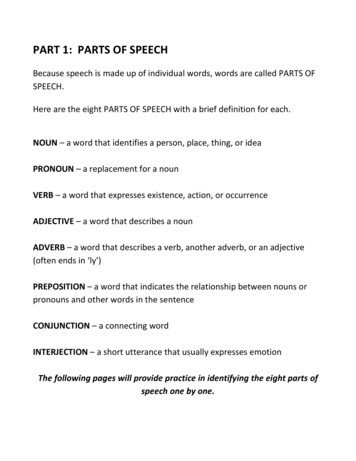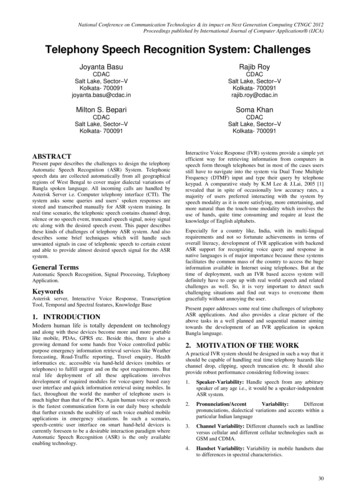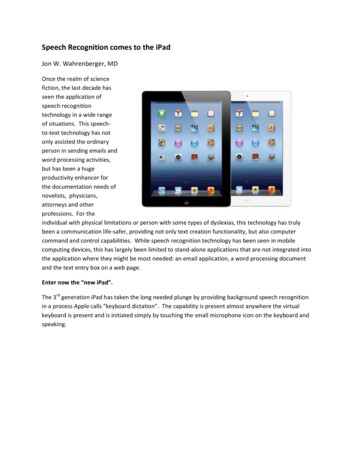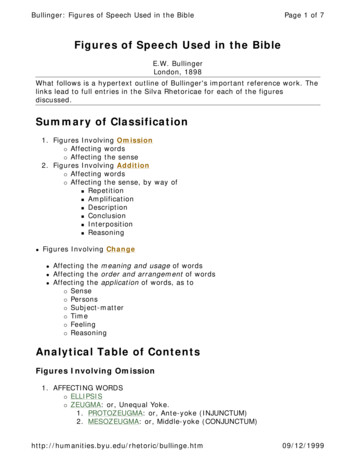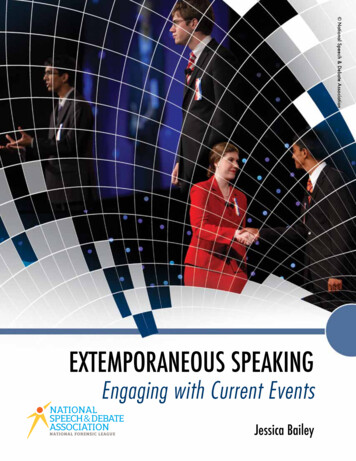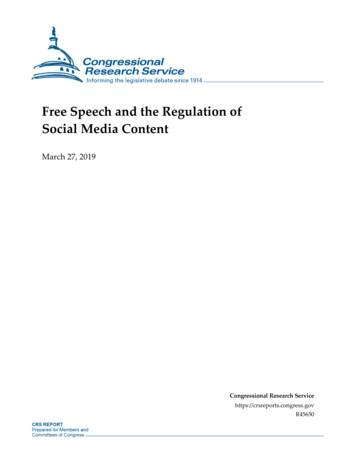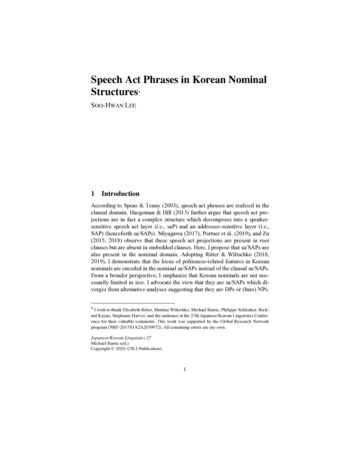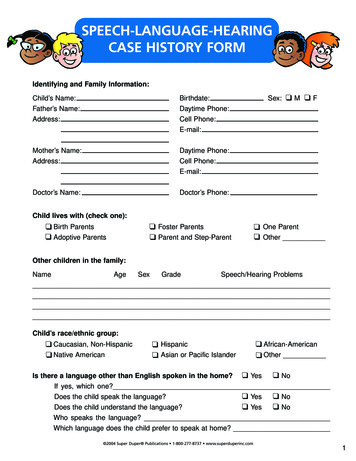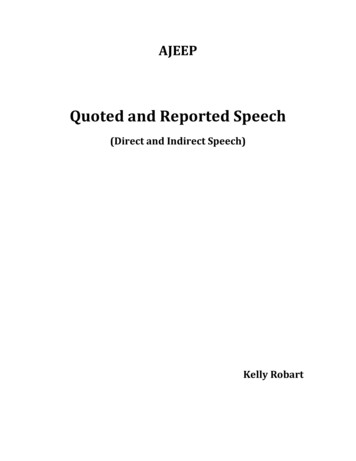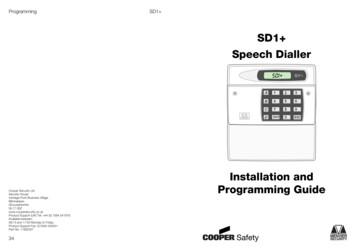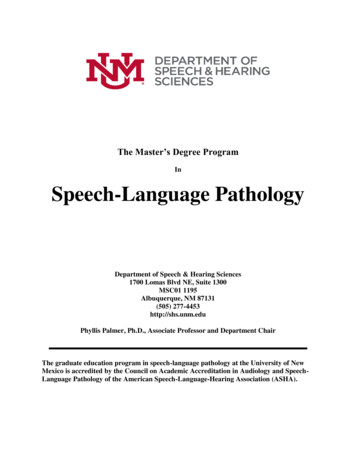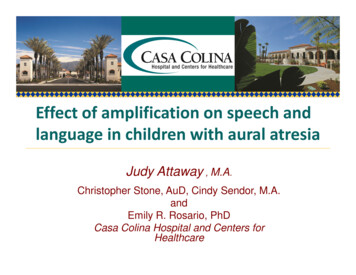
Transcription
Effect of amplification on speech andlanguage in children with aural atresiaJudy Attaway , M.A.Christopher Stone, AuD, Cindy Sendor, M.A.andEmily R. Rosario, PhDCasa Colina Hospital and Centers forHealthcare
Casa Colina HospitalandCenters for Healthcare Free standing Acute Rehabilitation Hospital inPomona California. Outpatient services with specialist physicians,specialized therapists (vestibular, pool, wheelchairseating) Audiology Program (started in 2002) is a part of theOutpatient services and works closely with inpatient,outpatient, physical therapy, occupational therapy,speech therapy, and children services.
Why the interest in children with Microtia/ Atresia Newborn Hearing Screening Program Large population of children with microtia/ atresia inthe inland empire. Lack of clinical guidelines for testing, and amplifyingthese children The push from early start to provide help for thesechildren.
Presentation Outline Background : Why this subject should be studied Hypothesis / Objectives : What we were hoping todiscover. Study Design: Who did we study? Results: What the results suggests. Conclusions / Clinical Implications: What should wetake from this study. What is next? My challenge to the Audiologycommunity.
Aural Atresia / Microtia Microtia– congenital deformity affecting the outer ear (pinna)– ear does not fully develop during the first trimester ofpregnancy– ear may be smaller in size, have a peanut shape, a smallnub or lobe, or be completely absent at birth– can affect one ear (unilateral) or both ears (bilateral)– occurs in every 1 out of 6,000 to 12,000 births– the right ear is more commonly affected Aural atresia– often associated with microtia– the absence or closure of the external auditory ear canal– malformation of the middle ear bones (incus, stapes, andmalleus) including the narrowing of the ear canal (stenosis)– may arise from problems in the fetus development ratherthan genetic factors
Aural Atresia Epidemiology The prevalence of unilateral atresia/microtia is significantlyhigher in Hispanic communities (Ramadhani et al., 2009). The large Hispanic population in southern California makesatresia a prevalent diagnosis (Shaw, Carmichael, Kaidarova,& Harris, 2004)– 0.67 versus 2.5 for every 10,000 live births in Hispanicpopulation Lower maternal education is also associated with anincreased risk of aural atresia in some studies (Shaw et al.,2004)
Hearing Loss and Language Development Hearing loss has the potential to significantly affect achild’s receptive and expressive vocabulary Such delays in speech and language abilities causelearning deficits Children with hearing loss have more difficulties withsocial skills Children with right unilateral hearing loss are more atrisk for difficulties with language tasks and verbalcognitive skills.
Unilateral Hearing Loss andAcademic Performance Overall academic performance has been found to belower in children with UHL when compared to childrenwith normal hearing Children with UHL have been shown to have worseacademic performance than children with bilateralhearing loss Children with right unilateral hearing loss repeat gradesmore often and have poorer performance on verbal teststhan those with left ear hearing loss
Atresia and Language Development High rates of speech therapy are identified in children withaural atresia– 86% of those with bilateral atresia had speech therapy– 43% of those with unilateral atresia had speech therapy A higher percent of children with right-sided atresiareported greater problems in school than those with leftsided atresia or bilateral atresia In school age children with aural atresia– 12.5% were using a hearing aid– 32% were using a FM system– 65% were reported as needing some resource i.e.,speech therapy, or were on an Individualized EducationPlan
Clinical Guidelines for Amplification Despite the research that children with hearing loss havemore delays in speech development and education, it is notstandard practice in many cases to provide amplification orother intervention until delays are evident. The 2013 guidelines put forth by the American Academy ofAudiology state that hearing aid amplification or otherintervention in children with unilateral hearing loss (UHL),sensorineural loss (SNL) or conductive hearing loss, shouldbe made on a case to case basis taking into consideration avariety of factors including child and family preference aswell as communication abilities and educational success The guidelines also state that we need to use reliable andvalid measures of a child's progress to assess earlyintervention goals in speech and language development
Does it make sense to wait Waiting on amplification until there is an indication ofcommunication delays or educational problems maydiminish the effectiveness of potential interventions. It has been suggested that children with hearing loss,who begin services early, both audiological andspeech / language therapy may develop language onpar with their peers without hearing loss Currently, there remains no specific clinical guidelinesconcerning intervention for conductive andsensorineural unilateral hearing loss,– when the intervention should be started– if amplification or assistive device should be used– what type of device is most effective
Amplification There are several types of hearing assistivedevices in addition to conventional hearing aidsthat may be considered including,– FM systems– CROS hearing aids– Transcranial amplification (both surgical andnon-surgical options) BAHA/Ponto Sofono
Hypothesis The goal of this study was to investigate the effect ofamplification through bone conduction on speech andlanguage development for children with aural atresia. Using current atresia patients in a single Audiology clinicwe studied speech and language development as itrelated to:– the time of first intervention– the compliance with wearing hearing aids andassistive devices– Differences in right verses left sided atresia– Differences in Bilateral verses unilateral atresia
Study ParticipantsInclusion criteria Male and female 3 and 6 years of age unilateral or bilateral conductive hearing loss due toaural atresiaExclusion criteriaParticipants were excluded from the study if they had mental in origin, such as Down Syndrome,cerebral palsy, or autism.
Study Design: Audiology Evaluation Participants completed an audiology exam which included, an analysis of pure tone air and bone conduction speech thresholds for each ear when possible usingpicture identification word recognition using Word Identification by PictureIdentification In participants currently using an amplification device an evaluation of the device was completed whichincluded, sound field warble tone threshold speech thresholds with masking to the unaided ear inunilateral cases computer analysis of device when possible (outputand data logging)
Study Design: Speech Evaluation All participants underwent a speech and languageevaluation conducted by a speech pathologist in thechild's primary language (English or Spanish) using, the Preschool Language Scale 4 to assesslanguage skills the Expressive and Receptive One-Word PictureVocabulary Tests (EOWPVT, ROWPVT) forvocabulary skills
Study Design: Children’s Outcome Worksheet A parent or legal guardian for each subject was askedto complete the Children’s Outcomes Worksheet (COW) The COW was designed to assess a child’s needs andabilities prior to and after amplification The COW provides a simple individualized assessmentof a child’s needs and subsequent assessment of howwell the rehabilitation process addresses those needs The COW determines if the fitting process resulted in achange in hearing ability and what is the child’s abilitylevel when aided
Results: Participant Characteristics
Time of first amplificationTime Between Birth and 1st Amplification Device3530Months2520151050BilateralUnilateralWhen comparing individuals with unilateral or bilateral auralatresia we observed that bilateral subjects on average were first fitwith devices at a younger age than unilateral subjects.
Aid use dailyAid Use lBilateral subjects report / log significantly longer daily usethan unilateral subjects.
Effect of AmplificationAverage reported changeChange Following tiesParents perceived greater improvement in response to sounds asmeasured by the COW in bilateral subjects versus unilateral subjects;however, parents did not perceive a difference in their child’s ability toact on the sounds in the environment.
Speech and Language DelaysSpeech and Language ralUnilateral There were no significant difference in speech and language abilities(as measured with the PLS-4, EOWPVT and ROWPVT) betweenbilateral and unilateral subjects. The bilateral participants did show a trend towards exhibiting greaterspeech and language delays.
Speech and Language DelaysDevelopmental Delays by AgeAge, Years6420Typical Development MIld DelaysSevere DelaysWhen speech and language delays (mean of the 3 tests) wereanalyzed according to severity we found that those with severedelays were the oldest,
Speech and Language DelaysDevelopmental Delays by Daily Aid Use8Aid use (hours)76543210Typical Development MIld DelaysSevere DelaysChildren with mild and severe delays wear their aids onaverage more than the typically developing subjects.
Speech and Language DelaysTime between birth and 1st fitting(months)Developmental delays and timebetween birth and 1st amplification device50403020100Typical Development MIld DelaysSevere DelaysChildren who are fit with their first amplification device laterexhibit more severe speech and language delays.
Developmental delays (months)Developmental DelaysDifferences between right and left side atresiaon developmental delaysRightLeft100-10*-20-30RightLeft Interestingly, among children with developmental delays those withright-sided atresia displayed greater delays. When looking at just the children with right sided atresia, typicallydeveloping children were fit on average one year earlier.
Conclusions Our study suggests that once aided, children with bilateralatresia display the same delays as those with unilateralatresia. The earlier the children were fit, the more compliant theywere at wearing the devices than children fit later. It goes to reason that children fit young will becomeaccustomed to the use of the band since the device whichmust be worn fairly tight and can be uncomfortable. Older children show greater resistance to the devices andultimately demonstrate less use and less benefit.
Conclusions While the sample size is small this data suggests thatfitting children earlier may prevent some delaysespecially with right-sided atresia Right-sided children who developed normal speechand language were fit one year earlier than theright-sided children with delays It is the right ear that is typically the dominant ear forprocessing speech information. It goes to reason that hearing loss on the right couldlead to more significant speech and languagedelays. The normal development of these auditorypathways is essential to learning and success in theclassroom.
Clinical Implications Findings from the present study are the beginnings of anattempt to help collect information to establish bestpractices regarding early intervention of children withatresiaThis population will spend considerable time in surgery forreconstruction and repair of their facial and auralstructures while the importance of hearing is oftenforgotten until they are noticeably delayed in school andsocial development.Since there is no research to verify the benefit of earlyfitting and the high cost of the device, many clinics choosenot fit until the child is older.If we are fitting children with ears at very young age whynot the atresia children.
Our Clinic Policy We have made it a policy to fit children with bilateral andunilateral atresia as young as possible. Children with unilateral hearing loss have problems inschool, with behavior, speech development and academicsuccess. In our opinion, it is not a child’s best interest to wait fordelays to occur before treating when there areintervention options which may help to prevent orminimize future educational and developmental problems. Findings from the present study are the beginnings of anattempt to help collect information to establish bestpractices regarding early intervention of children withatresia.
Need for further research There is no objective verification of the availability ofspeech information for the child using the device (such asspeech mapping). Further research in this area should include– attention to provide assurances that we are providingoptimal speech information to these children’sdeveloping ears and brain.– verification of the ability to localize sounds presentedby bone conduction both unilaterally and bilaterally.
Interesting ResearchBinaural hearing ability with bone conduction stimulation innormal hearing subjectsM. Seltooni, E. Maki-Torkko, S. Stenfelt Conclusion:– Spatial release from masking in a stationary noise withspeech targets was around 5 dB with BC mastoidapplication– Patients with bilateral conductive impairments and goodcochlea's should be fitted bilaterally.– We need BCHAs that are adapted for binauralapplication
THANK YOU!Supporting this Research: Casa Colina Foundation and Casa Colina Board of Directors
References ASHA, American Speech-Language-Hearing Association. (2008). Loss to follow-up inearly hearing detection and intervention [Technical Report].Borg, E., Risberg, A., McAllister, B., Undemar, B. M., Edquist, G., Reinholdson, A. C.(2002). Language development in hearing-impaired children. Establishment of areference material for a 'Language test for hearing-impaired children', LATHIC. Int JPediatr Otorhinolaryngol, 65(1), 15-26. doi: S0165587602001209 [pii]Ching, Teresa, Galaster, Jason, Grimes, Alison, Johnson, Cheryl, Lewis, Dawna,McCreery, Ryan. (2013). American Academy of Audiology Clinical Practice Guidelines Pediatric Amplification. American Academy of Audiology.Hayiou-Thomas, M. E., Harlaar, N., Dale, P. S., & Plomin, R. (2010). Preschool speech,language skills, and reading at 7, 9, and 10 years: etiology of the relationship. J SpeechLang Hear Res, 53(2), 311-332. doi: 53/2/311 [pii]10.1044/1092-4388(2009/07-0145)Jensen, D. R., Grames, L. M., & Lieu, J. E. (2013). Effects of Aural Atresia on SpeechDevelopment and Learning: Retrospective Analysis From a MultidisciplinaryCraniofacial Clinic. JAMA Otolaryngol Head Neck Surg. doi: 1714362 [pii]10.1001/jamaoto.2013.3859Kesser, B. W., Krook, K., & Gray, L. C. (2013). Impact of unilateral conductive hearing lossdue to aural atresia on academic performance in children. Laryngoscope, 123(9), 22702275. doi: 10.1002/lary.24055Klee, T. M., & Davis-Dansky, E. (1986). A comparison of unilaterally hearing-impairedchildren and normal-hearing children on a battery of standardized language tests. EarHear, 7(1), 27-37.Lieu, J. E. (2004). Speech-language and educational consequences of unilateral hearingloss in children. Arch Otolaryngol Head Neck Surg, 130(5), 524-530. doi:10.1001/archotol.130.5.524130/5/524 [pii]
References Lieu, J. E., Tye-Murray, N., Karzon, R. K., & Piccirillo, J. F. (2010). Unilateral hearingloss is associated with worse speech-language scores in children. Pediatrics, 125(6),e1348-1355. doi: peds.2009-2448 [pii]10.1542/peds.2009-2448McKay, S. (2010). Audiological Management of Children with Single-Sided Deafness.Seminars in Hearing, 31(4), 290 - 303.McKay, S., Gravel, J. S., & Tharpe, A. M. (2008). Amplification considerations forchildren with minimal or mild bilateral hearing loss and unilateral hearing loss.Trends Amplif, 12(1), 43-54. doi: 12/1/43 [pii]10.1177/1084713807313570Most, T. (2004). The effects of degree and type of hearing loss on children'sperformance in class. Deaf Educ Int, 6(3), 154-166.Peckham, C. S., & Sheridan, M. D. (1976). Follow-up ?at II years of 46 children withsevere unilateral hearing loss at 7 years. Child Care Health Dev, 2(2), 107-111.Ramadhani, T., Short, V., Canfield, M. A., Waller, D. K., Correa, A., Royle, M. (2009).Are birth defects among Hispanics related to maternal nativity or number of yearslived in the United States? Birth Defects Res A Clin Mol Teratol, 85(9), 755-763. doi:10.1002/bdra.20584Shaw, G. M., Carmichael, S. L., Kaidarova, Z., & Harris, J. A. (2004). Epidemiologiccharacteristics of anotia and microtia in California, 1989-1997. Birth Defects Res AClin Mol Teratol, 70(7), 472-475. doi: 10.1002/bdra.20042
Casa Colina Hospital and Centers for Healthcare Free standing Acute Rehabilitation Hospital in Pomona California. Outpatient services with specialist physicians, specialized therapists (vestibular, pool, wheelchair seating) Audiology Program (started in 2002) is a part of

